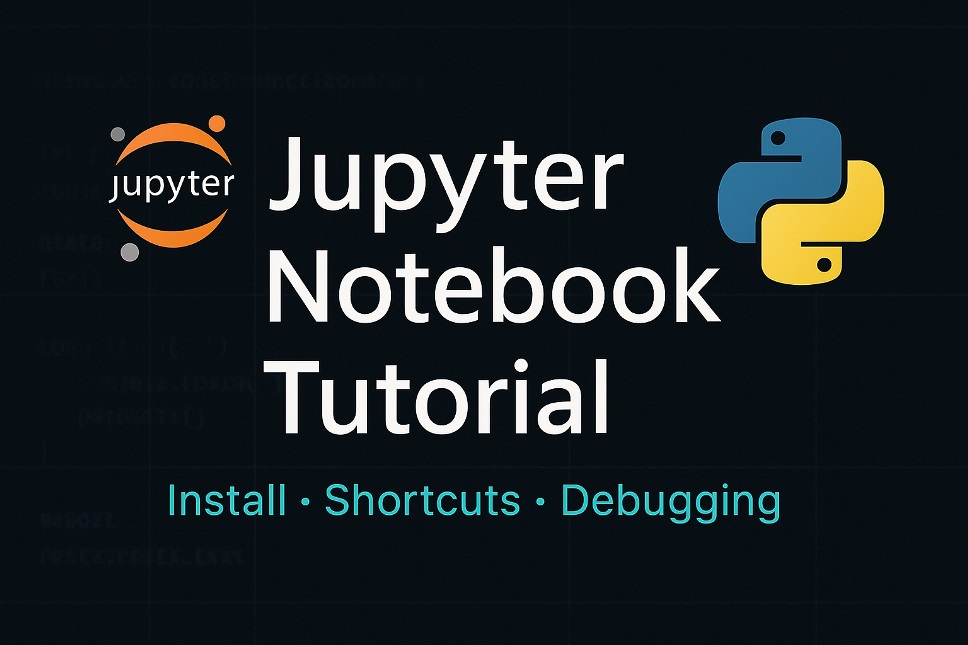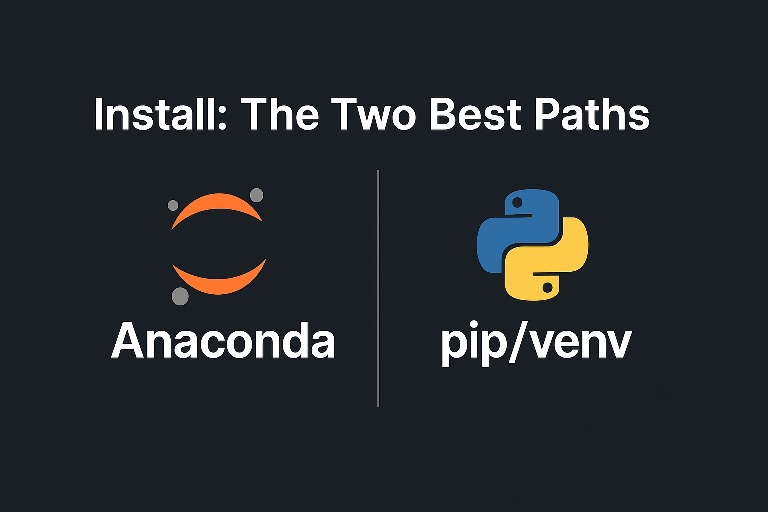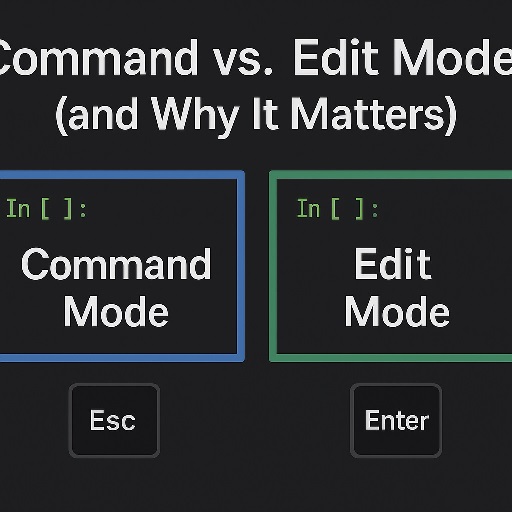
Jupyter is the workbench many Python users open first. In this jupyter notebook tutorial, we’ll start with the basics—installing and launching—then level up with power-user shortcuts, lightweight profiling, and practical debugging. The goal is a smooth, fast workflow you can trust for data analysis, prototyping, and teaching.
This guide also answers common questions like how to use jupyter notebook, whether is jupyter notebook free, how it compares to a jupyter tutorial you might find elsewhere, and how to run code in python jupyter notebook—all woven naturally into the sections below.
1) Install: The Two Best Paths

Anaconda (all-in-one, easiest)
If you want a zero-friction setup that bundles Python, common packages, and Jupyter, install Anaconda:
- Download Anaconda for your OS (Windows/macOS/Linux).
- Follow the installer’s prompts and add Anaconda to your PATH if asked.
- Launch “Anaconda Navigator” and click “Notebook,” or use the terminal:
jupyter notebook
Why choose Anaconda? It’s beginner-friendly, includes scientific libraries, and isolates projects via conda environments.
pip (lean, flexible)
Prefer a minimal install or already comfortable with virtual environments?
- Create and activate a virtual environment:
python -m venv .venv # Windows: .venv\Scripts\activate # macOS/Linux: source .venv/bin/activate - Install Jupyter:
pip install notebook - Run:
jupyter notebook
Tip: For JupyterLab (a more modern interface with tabs and a visual debugger), install:
pip install jupyterlab
jupyter lab
2) Launch & Orientation

When you run the command, your default browser opens the Jupyter file browser. Click New → Python to create a notebook. You’ll see cells—the building blocks of computation and narrative. Two cell types matter most:
- Code cells: execute Python and display outputs beneath.
- Markdown cells: format text, equations, and images for readable documentation.
Save often (Ctrl/Cmd + S), and keep related notebooks, data, and environment files together for reproducibility. Throughout this jupyter notebook tutorial, treat each notebook like a documented experiment: one idea per file, clear headings, and version control with Git where possible.
3) Command vs. Edit Mode (and Why It Matters)

Jupyter’s dual modes are key to speed:
- Edit mode (green border): You’re typing inside a cell.
- Command mode (blue border): You’re operating on cells (add, delete, move).
Press Esc to enter Command mode; Enter to edit the selected cell.
Execution basics
- Shift + Enter: run cell, move down
- Ctrl/Cmd + Enter: run cell, stay
- Alt + Enter: run cell, insert below
4) Essential Shortcuts for Daily Use
Keep bullet points minimal—here are just the must-know ones (from Command mode unless noted):
- A / B: insert cell Above/Below
- D, D (press D twice): delete cell
- M / Y: convert to Markdown / Code
- Z: undo cell operation
- Shift + M: merge selected cells
- Ctrl/Cmd + / (in Edit mode): toggle comment lines
Customize shortcuts via Help → Edit Keyboard Shortcuts. Small wins here compound—your notebook feels snappier and more “IDE-like” the more you lean on the keys.
Also Read: Egerp Panipat: Powering Growth with Tailored ERP
5) Profiling: Quick Performance Checks
Before deep optimization, measure. Jupyter includes convenient IPython magics:
%time(single run) and%timeit(multiple runs) for wall-clock timing.%timeit [x*x for x in range(10_000)]%%timefor cell-level timing:%%time total = 0 for i in range(10_000): total += i*i
For function-level breakdowns, use Python’s built-in profiler:
import cProfile, pstats, io
pr = cProfile.Profile()
pr.enable()
# --- code to profile ---
pr.disable()
s = io.StringIO()
ps = pstats.Stats(pr, stream=s).sort_stats('cumtime')
ps.print_stats(10)
print(s.getvalue())
Need line-by-line hotspots? Pair your environment with line_profiler and run %lprun in IPython after installing the extension.
Practical workflow: time first, profile second, then refactor. Cache expensive operations, vectorize with NumPy, and push heavy loops to compiled libraries when possible.
6) Debugging: From Print to Breakpoints
Start with the basics—small, testable cells and explicit variable names. When errors arise, you have options:
- Inline traceback navigation: Jupyter shows the line that failed; fix and rerun the cell.
- Post-mortem debugging with
%debug:
After an exception, run%debugto drop into an interactive debugger at the error point. Inspect variables withp, move up/down the stack withu/d, andqto quit. - Step-through debugging: In IPython, you can also use:
%run -d myscript.pyfor script-level debugging, or integrateipdbfor familiar step/next/continue commands. - JupyterLab Debugger: If you prefer a UI, JupyterLab offers a panel for breakpoints, call stacks, and variable views when kernels support it.
Common fixes
- Kernel state drift: If variables feel “haunted,” restart the kernel (Kernel → Restart) and rerun from top.
- Dependency mismatch: Pin versions in
requirements.txtorenvironment.yml. Recreate the environment if imports break. - Path issues: Use
pathliband project-relative paths; avoid brittlesys.pathhacks.
7) Best Practices for Reliable Notebooks
- One narrative: open with goals, finish with conclusions.
- Deterministic runs: use
# %%sections, set random seeds, and run all cells top-to-bottom before sharing. - Data safety: avoid hard-coding secrets; use environment variables or
.envfiles (never commit them). - Scaling out: for big data or GPU work, consider Jupyter on remote servers (VS Code tunnels, cloud notebooks) and keep notebooks light by offloading heavy logic to modules.
Conclusion
This jupyter notebook tutorial took you from install to expert habits: launching clean environments, moving fast with shortcuts, validating performance with quick profiling, and solving bugs with practical debugging tools. Treat notebooks like living lab reports—measured, reproducible, and readable—and you’ll get reliable results whether you’re prototyping, analyzing, or teaching.
FAQs
1) Is Jupyter suitable for beginners?
Yes. You can run code cell-by-cell, see immediate outputs, and mix explanations with results—ideal for learning and exploration.
2) Can I share notebooks with teammates?
Absolutely. Commit .ipynb files to Git, export to HTML/PDF for non-technical stakeholders, or use services like nbviewer for easy viewing.
3) How do I speed up slow notebooks?
Start with %timeit and cProfile, then refactor hot loops, cache results, and move heavy code into functions or compiled libraries (NumPy, Numba).
4) What’s the difference between Notebook and JupyterLab?
Notebook is the classic interface; JupyterLab adds tabs, file trees, terminals, and a visual debugger. Both run the same kernels.
5) How do I keep my environment stable?
Use conda or venv, pin dependencies, and rebuild environments from environment.yml or requirements.txt to avoid “works on my machine” issues.